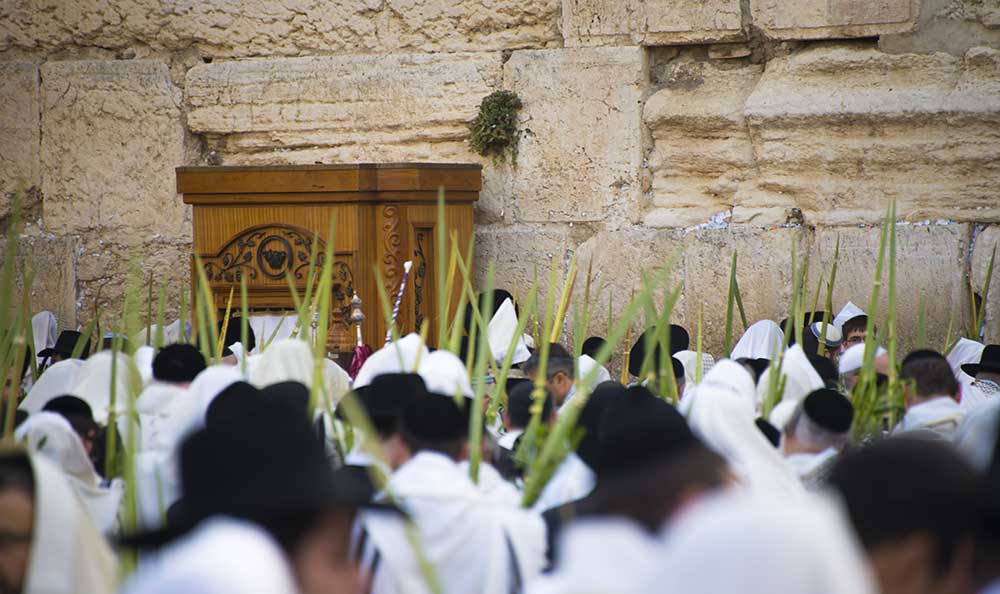We have now all heard the blowing of the shofar on Rosh HaShanah and survived the fast of Yom Kippur. So it is now that time of year where we get to explain what that hut is we are building in the back yard. I remember a few years back my neighbor asking me if I was putting in a hot tub with a gazebo. When you think about it, it’s funny and sad at the same time.
For the earliest believers, both Jewish and Gentile, the rhythm of the biblical festivals complete with the celebration of Sukkot, was a natural part of their faith. In fact, when we get attuned to the symbolism of the holiday, we realize that so many passages in the New Testament simply assume that all followers of Messiah are observing Sukkot. A great example is Revelation chapter 7, which describes a scene where all nations are appearing before Messiah:
After this I looked, and behold, a great multitude that no one could number, from every nation, from all tribes and peoples and languages, standing before the throne and before the Lamb, clothed in white robes, with palm branches in their hands, and crying out with a loud voice, “Salvation belongs to our God who sits on the throne, and to the Lamb!” … Therefore they are before the throne of God, and serve him day and night in his temple; and he who sits on the throne will shelter them with his presence. (Revelation 7:9-10, 15)
This motif clearly evokes the prophetic utterances of Zechariah in which everyone from the nations will come up to Jerusalem “to keep the Feast of Booths.”[1] Here in Revelation, the nations come up to the throne of God in the Temple with palm branches in their hands, which are the lulav (לולב) that the Torah commands to be waved on Sukkot.[2]

Celebrating Sukkot — Jews and believers from around the world gather at the Kotel in Jerusalem with the four species in hand to worship the King. (Image © First Fruits of Zion)
Midrash Tehillim teaches that when the Messiah comes he will instruct the nations in the commandments of sukkah and lulav and indeed Rashi even feels, based on Zechariah 14, that these commandments will be incumbent upon them in the Messianic Era.[3] In Revelation 7:17 we find mention of “springs of living water,” which appears to be a veiled reference to the water-pouring ceremony that took place in the Temple each morning of Sukkot,[4] thus reflecting major imagery of Sukkot.[5]
The Sukkot imagery in Revelation is intelligible only if it were written to a community of believers that was actually participating in the festivals of Israel. The communities reading Revelation were most assuredly made up of both Jewish and Gentile believers who celebrated Sukkot with the anticipation that the entire world would do so in the Messianic Age. Gentiles in Messiah celebrating it now are the firstfruits of that glorious time.
Some scholars also see a connection between Sukkot and the later Feast of Encaenia (“Church Dedication”), both of which took place in the same season, lasted eight days, and were a time of pilgrimage to Jerusalem (with Sukkot to the Temple and with Encaenia to the Church of the Holy Sepulchre). Goudoever writes that “from the fourth century on, the Feast of Dedication is kept as a continuation of the third great Israelite feast [i.e., Sukkot].[6] There also appears to be a clear reference to Gentiles observing Sukkot in John Chrysostom’s rebuke of those who, along with the Jews, had “tents … pitched among them.”[7]
Each year when we build our sukkah and wave our lulav and etrog, we can rest assured that we are reviving the practice of the earliest followers of Yeshua who celebrated this season of joy.
Footnotes:
- Zechariah 14:16-19.
- Leviticus 23:40. See m.Sukkah 3:1ff.
- Midrash Tehillim 21; Rashi to Zechariah 14:16-19. Cf. y.Avodah Zarah 2:1.
- m.Sukkah 4:9.
- Hakan Ulfgard, Feast and Future: Revelation 7:9-17 and the Feast of Tabernacles (Lund, Sweden: Wallin and Dalholm, 1989). Also see Hakan Ulfgard, The Story of Sukkot: The Setting, Shaping, and Sequel of the Biblical Feast of Tabernacles (Tubingen, Germany: Mohr Siebeck, 1998), 274-279 for a detailed discussion of later church fathers’ eschatological interpretations of Sukkot.
- Van Goudoever, Biblical Calendars (Leiden, Netherlands: Brill, 1961), 214; see also 210-213.
- Chrysostom, Against the Jews 9:2.
Source: First Fruits of Zion
